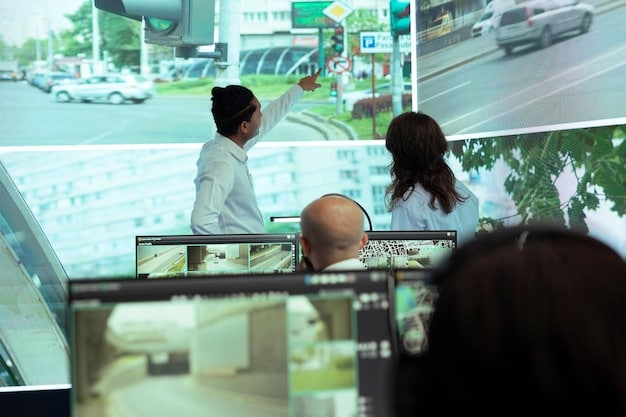AI and Autonomous Vehicles: Road Safety in the US

AI and Autonomous Vehicles: When Will Self-Driving Cars Be Safe for US Roads? delves into the current state of self-driving car technology, safety challenges, regulatory hurdles, and projections for when these vehicles will be safe for widespread use on US roads.
Are self-driving cars on the horizon or still a distant dream? This article explores AI and Autonomous Vehicles: When Will Self-Driving Cars Be Safe for US Roads?, examining the progress, challenges, and future of self-driving technology in the United States.
The Promise of AI in Autonomous Vehicles
Artificial intelligence is revolutionizing transportation, and autonomous vehicles are at the forefront. These vehicles promise to enhance safety, reduce traffic congestion, and provide mobility for those who cannot drive. The integration of AI is pivotal in making self-driving cars a reality.
AI algorithms enable cars to perceive their surroundings, make decisions, and navigate complex environments. But how far away are we from truly safe self-driving cars in the US?
AI’s Role in Vehicle Autonomy
AI plays a critical role in several aspects of autonomous driving. From perceiving the environment to making real-time decisions, AI algorithms are the brains behind self-driving technology.
- Perception: AI algorithms process data from sensors like cameras, lidar, and radar to create a 3D understanding of the surroundings.
- Decision-Making: Based on the perceived environment, AI algorithms make decisions about steering, acceleration, and braking.
- Navigation: AI algorithms plan and execute routes, taking into account traffic conditions, road signs, and other factors.
Advancements in AI are continuously improving the capabilities of autonomous vehicles, making them safer and more reliable. However, challenges remain in ensuring these systems can handle all real-world driving scenarios.
In conclusion, the promise of AI in autonomous vehicles is immense. However, realizing this promise requires continuous innovation, rigorous testing, and a commitment to safety.
Current State of Self-Driving Technology
Self-driving technology has made significant strides in recent years. Companies like Tesla, Waymo, and Cruise are actively testing and deploying autonomous vehicles in various cities across the United States.
While fully autonomous vehicles are not yet widely available, the technology is rapidly evolving. Here’s a look at the current state of self-driving technology.

Levels of Automation
The Society of Automotive Engineers (SAE) has defined six levels of driving automation, ranging from 0 (no automation) to 5 (full automation). Most vehicles on the road today are at levels 0-2, with some advanced driver-assistance systems (ADAS).
- Level 0 (No Automation): The driver controls all aspects of driving.
- Level 1 (Driver Assistance): The vehicle provides some assistance, such as adaptive cruise control or lane keeping.
- Level 2 (Partial Automation): The vehicle can control steering and acceleration under certain conditions, but the driver must remain attentive and ready to take over.
- Level 3 (Conditional Automation): The vehicle can handle most driving tasks in specific situations, but the driver must be ready to intervene when needed.
Companies like Waymo and Cruise are testing vehicles at levels 4 and 5, which require minimal or no human intervention. Achieving these levels safely and reliably is the ultimate goal of autonomous vehicle development.
In summary, the current state of self-driving technology is rapidly advancing, but significant challenges remain before fully autonomous vehicles become commonplace.
Safety Challenges and Accident Analysis
Ensuring the safety of autonomous vehicles is a paramount concern. Despite technological advancements, self-driving cars have been involved in accidents, raising questions about their readiness for widespread deployment.
Analyzing these incidents is crucial for identifying areas where improvements are needed. Understanding the safety challenges is essential for building public trust and ensuring the safe adoption of autonomous vehicles.
Common Causes of Accidents
Several factors contribute to accidents involving self-driving cars. These include sensor limitations, software glitches, and unpredictable human behavior.
- Sensor Limitations: Sensors may struggle in adverse weather conditions like heavy rain, snow, or fog.
- Software Glitches: Software errors can lead to incorrect decisions and unexpected behavior.
- Unpredictable Human Behavior: Human drivers, pedestrians, and cyclists can behave unpredictably, posing challenges for autonomous systems.
Analyzing Accident Data
Analyzing accident data provides valuable insights into the performance of self-driving cars. It helps in identifying patterns, understanding the causes of accidents, and developing strategies to prevent future incidents.
Studies have shown that autonomous vehicles are often involved in minor collisions, such as rear-end accidents, which are often attributed to cautious programming. However, more serious accidents have also occurred, highlighting the need for further improvements.
In conclusion, addressing safety challenges and analyzing accident data is vital for enhancing the safety and reliability of autonomous vehicles.
Regulatory Landscape and Legal Hurdles
The regulatory landscape for autonomous vehicles is still evolving. States and federal agencies are grappling with how to regulate this emerging technology. Legal hurdles, such as liability in the event of an accident, also need to be addressed.
Navigating this complex regulatory and legal environment is crucial for the successful deployment of self-driving cars.
Federal vs. State Regulations
Both federal and state governments have a role in regulating autonomous vehicles. Federal regulations focus on vehicle safety standards, while states handle issues such as licensing and traffic laws.
The National Highway Traffic Safety Administration (NHTSA) is responsible for setting federal safety standards. However, these standards are not yet fully adapted to autonomous vehicles, creating a regulatory gap.

Liability and Insurance Issues
Determining liability in the event of an accident involving a self-driving car is a complex legal issue. Who is responsible if a fully autonomous vehicle causes an accident – the manufacturer, the software developer, or the owner?
Insurance companies are also working to develop new policies that cover autonomous vehicles. These policies must address issues such as data security, software updates, and remote control capabilities.
In summary, navigating the regulatory landscape and addressing legal hurdles is essential for the safe and responsible deployment of autonomous vehicles.
Public Perception and Trust in AI
Public perception plays a significant role in the adoption of self-driving cars. Many people are still wary of trusting a machine to drive them safely. Building public trust is crucial for the widespread acceptance of autonomous vehicles.
Addressing concerns about safety, security, and job displacement is essential for fostering a positive perception of AI in transportation.
Addressing Safety Concerns
Safety is the primary concern for most people when it comes to self-driving cars. Demonstrating that these vehicles are safer than human drivers is key to building trust.
- Transparency: Providing clear and accessible information about the technology and its limitations.
- Testing: Conducting rigorous testing in a variety of conditions to ensure safety and reliability.
- Education: Educating the public about the benefits and risks of autonomous vehicles.
Impact on Employment
The introduction of self-driving cars could have a significant impact on employment, particularly for professional drivers. Addressing these concerns and providing retraining opportunities is crucial for mitigating negative consequences.
Some argue that autonomous vehicles could create new jobs in areas such as software development, maintenance, and data analysis. However, proactive measures are needed to ensure a smooth transition for affected workers.
In conclusion, building public trust and addressing concerns about safety and employment are essential for the successful adoption of self-driving cars.
Future Projections and Timelines
Predicting when self-driving cars will be safe for widespread use is challenging. Various experts have offered different timelines, depending on factors such as technological advancements, regulatory approvals, and public acceptance.
While the exact timeline remains uncertain, it is clear that autonomous vehicles will play an increasingly important role in the future of transportation.
Technological Advancements
Continued advancements in AI, sensor technology, and software development are essential for improving the safety and reliability of self-driving cars.
Innovations such as advanced lidar systems, improved object recognition algorithms, and more sophisticated decision-making capabilities will pave the way for safer autonomous vehicles.
Expert Predictions
Experts offer a range of predictions for when autonomous vehicles will be safe for widespread use. Some believe that fully autonomous vehicles will be common within the next decade, while others are more cautious.
Factors such as regulatory hurdles, public perception, and the pace of technological innovation will influence the timeline. It is likely that autonomous vehicles will be introduced gradually, starting with limited applications in controlled environments.
In summary, the future of autonomous vehicles is promising, but realizing this potential requires continued innovation, collaboration, and a commitment to safety.
| Key Point | Brief Description |
|---|---|
| 🤖 AI Integration | AI is crucial for perception, decision-making, and navigation in autonomous vehicles. |
| 🚦 Regulatory Hurdles | Federal and state regulations need to adapt to autonomous vehicles for safe deployment. |
| 🛡️ Safety Concerns | Addressing sensor limitations and unpredictable human behavior is vital for safety. |
| 🤝 Public Trust | Building trust through transparency, testing, and education is crucial for adoption. |
Frequently Asked Questions (FAQ)
▼
The main challenges include sensor limitations in adverse weather, software glitches, dealing with unpredictable human behavior, and navigating complex regulatory landscapes.
▼
AI algorithms enhance safety by enabling vehicles to perceive their surroundings, make real-time decisions, and navigate routes effectively. This includes processing data from cameras, lidar, and radar.
▼
The levels range from 0 (no automation) to 5 (full automation). Levels 0-2 require driver control, while levels 3-5 involve increasing degrees of vehicle autonomy and minimal human intervention.
▼
Liability is a complex legal issue. It could fall on the manufacturer, software developer, or owner, depending on the circumstances. New insurance policies are being developed to address these issues.
▼
Public trust can be improved through transparency, rigorous testing, and education. Addressing safety concerns, security issues, and potential job displacement is also crucial for fostering trust.
Conclusion
In conclusion, the journey toward safe and reliable self-driving cars in the US is ongoing. While AI and Autonomous Vehicles: When Will Self-Driving Cars Be Safe for US Roads? is still a complex question, continued technological advancements, regulatory clarity, and efforts to build public trust will pave the way for a future where autonomous vehicles enhance mobility and safety on our roads.





